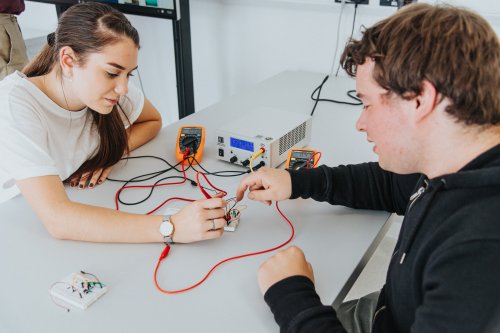If you’re thinking about studying beyond your undergraduate degree (or skipping straight to an integrated master’s), you might be wondering: what are the different types of master’s degrees? And how do you choose the right one for your future?
Whether you’re exploring advanced study options in engineering or just starting your research, this guide breaks it all down - including the difference between postgraduate and undergraduate master’s degrees, how long they take, and where NMITE’s MEng fits in.
Why do a master’s degree?
A master’s degree isn’t just about more time in education – it’s about what that extra time can do for you and your career.
Here’s some reasons why students choose to study a master’s as their next step:
- Specialist knowledge – Go beyond the basics and focus on a subject or area you’re passionate about.
- Career progression – Open doors to higher-level roles, management positions, and new industries.
- Professional recognition – Many careers (especially in engineering) require a master’s for full accreditation, membership of professional bodies, or chartership.
- Better pay and prospects – On average, postgraduates earn more over their careers than those with undergraduate-only degrees.
- A route into research or academia – If you’re thinking about a PhD, a master’s is often the next step.
Whether you're aiming to build advanced technical skills, stand out in a competitive job market, or take the first step toward professional chartership, a master's could be the smart next move.
At NMITE, our MEng programmes are designed to help you do exactly that — through hands-on projects, employer engagement, and accelerated learning that gets you career-ready, faster.
What are the different types of master’s degrees?
When people talk about doing a master’s, they usually mean a higher-level qualification you take after an undergraduate degree (like a BSc or BA). It’s your chance to go deeper into a subject, gain specialist knowledge, or prepare for roles in research, leadership, or industry.
But here’s the thing: not all master’s degrees are created equal.
Depending on where you are in your education journey, there are a few different routes you can take - and knowing the difference can help you choose the one that fits your goals best.
Here’s a simple breakdown:
1. Postgraduate Master’s Degrees
This is what most people picture when they hear the word “master’s”. You complete your undergraduate degree, then apply for a standalone master’s.
Common types include:
- MSc (Master of Science) – Popular in engineering, science, and tech.
- MA (Master of Arts) – Focused on arts and humanities subjects.
- MBA (Master of Business Administration) – For future leaders and entrepreneurs.
- MRes (Master of Research) – Heavily research-based, often a step toward a PhD.
- MEng (Master of Engineering) – Sometimes offered this way, though it’s more commonly integrated (see below).
How long it takes:
Usually 1 year full-time, or 2 years part-time.
How you apply:
Through UCAS Postgraduate or directly to the university.
Entry requirements:
Typically a 2:1 or 2:2 undergraduate degree, but this can vary.
2. Integrated Master’s Degrees (like NMITE’s MEng)
Integrated master’s degrees are a bit different and a lot more streamlined.
Rather than doing a bachelor’s and then applying separately for a master’s, you apply once for a single, continuous course that includes both. It’s ideal if you already know you want to go further.
Example:
- MEng (Master of Engineering) – Combines a bachelor’s and master’s degree into one.
At NMITE, our accelerated MEng in Integrated or Mechanical Engineering lets you:
- ✅ Graduate with a master’s in just three years (instead of four)
- ✅ Build advanced engineering skills from day one
- ✅ Skip the stress of reapplying - it’s all one course
Who it’s for:
Students ready to hit the ground running and graduate industry-ready, faster.
Worried about entry requirements?
We offer a Foundation Year route – so you can still get onto the full MEng path.
3. Other Master’s-Level Qualifications
There are a few shorter or more specialised options worth knowing about too:
- PGDip (Postgraduate Diploma): A shorter version of a master’s, focused on practical skills.
- PGCert (Postgraduate Certificate): Even shorter – great for CPD or targeted knowledge.
- MPhil (Master of Philosophy): A research-intensive option, often leading into a PhD.
These are great if you’re looking to upskill in a specific area or take your first steps into academic research.
So, what’s the best master’s degree for engineering?
That depends on:
- How soon you want to graduate
- Whether you already have a degree
- How hands-on you want your learning to be
If you're starting out and want a faster, more practical route to becoming an engineer - NMITE’s Integrated and Mechanical MEng degrees are a smart move.
You’ll learn:
- In small teams, solving real-world problems from day one
- With no lecture theatres and no traditional exams
- On a course co-designed with employers
Plus, you’ll finish with a full master’s degree in just 3 years, saving time and money - and starting your engineering career sooner.
Choosing the right master’s for you
Master’s degrees come in all shapes and sizes – from standalone MScs to integrated MEng routes. The best choice isn’t about picking the “hardest” or “most prestigious” option; it’s about what fits your goals, learning style and career ambitions.
If you’re ready to learn by doing, work on real employer projects and graduate with advanced skills faster, NMITE’s accelerated MEng in Integrated or Mechanical Engineering could be your ideal route. It’s designed for people who don’t just want to study engineering – they want to start building it.
Want to know more?
- Explore NMITE’s degrees in full
- Apply direct – no UCAS needed.
- Call us on 01432 371111 for a chat (no bots, just real people)
Related blogs:






